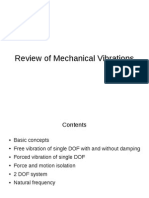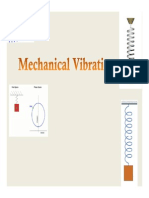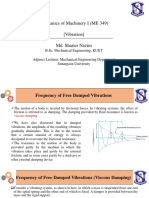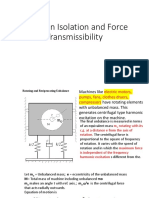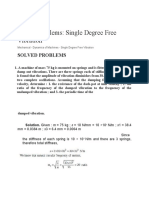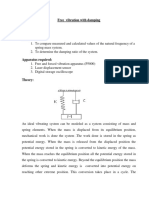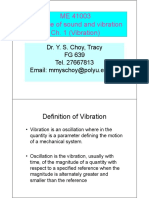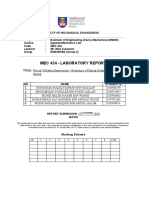0 ratings0% found this document useful (0 votes) 126 views8 pagesVibration WORKED EXAMPLES
Mechanical Engineering Principles
Copyright
© © All Rights Reserved
We take content rights seriously. If you suspect this is your content,
claim it here.
Available Formats
Download as PDF or read online on Scribd
Example 1 4 vibrating system consists of a mass of 200 kg, a spring of stiffness
80 Ninm and a damper wath damping coefficient of 800 Nim/s. Determine the frequency of vibration
of the system.
Solution. Given : m = 200 kg ; s = 80 N/mm = 80 « 103 Nim ; c= 800 Nims
We know that circular frequency of nndamped vibrations,
-fi 80x10
On 200
0 rad/s�and circular frequency of damped vibrations,
04 = Y(o,) -@ =, -(¢/2my? ws a=e/2n)
= (20)? - (00/2200)
9.9 rads
Frequency of vibration of the system,
fg = 0g (2=19.9/ IM = 3.17 Hz
Example 2. The following data are given for a vibratory system with viscous damping:
Mass = 2.5 kg ; spring constant = 3 Ninm and the amplitude decreases to 0.25 of the
initial value after five consecutive cycles.
Determine the damping coefficient of the damper in the system.
Solution. Given : m = 2.5 kg ; s = 3 N/mm = 3000 Nim ; xg = 0.25 x
We know that natural cireular frequeney of vibration,
s _ [3000
©, = — =) = = 34.64 rad/s
m 25
Let = Damping coefficient of the damper in Naw,
Initial amplitude, and
xg ~ Final amplitude afier five consecutive cycles = 0.25 x, «..(Given)
‘We know that
My X83 My XS
My MyM�We know that
tog,( 22 Joan 2%
"2 (@,) =
2
log, (1.32)=ax—=—_ or ~— 0.2776 = U2
¥Ga.e4y? -a? 120
Squaring both sides,
39.50 2 2
0.077 = ——_ or 92.4—-0.077 aX =39.5ar
1200-a
We know that
2335 of a= 153
c/Im or ¢=axQm= 153% 2x25=7.65 Nim's
Example 3 The measurements on a mechanical vibrating system show that it has a
‘mass of 8 kg and that the springs can be combined 10 give an equivalent spring of stiffness
5.4 Ninm, If the vibrating system have a dashpot attached which exerts a force of 40.N when the
‘mass has a velocity of I m/s, find : 1. erttical damping coefficient, 2. damping factor, 3. logarithmic
decrement, and 4. ratio of two consecutive amplitudes.
Solution. Given : m = 8 kg : 5 = 5.4 Nim = 5400 Nin
Since the force exerted by dashpot is 40 N, and the mass has a velocity of 1 u/s , therefore
Damping coefficient (actual),
c= 40 Nim's�1. Critical damping coefficient
We know that critical damping coefficient,
5400
= Ima, = 2x, FP =2«8 FP = 416 Nims
m 8
2. Damping factor
‘We know that damping factor
3. Logarithmic decrement
‘We know that logarithmic decement,
2ne 2nx40
ere fete? co
4. Ratio of two consecutive amplitudes
5
Let x, and x,,, = Magnitude of two consecutive amplitudes,
We know that logarithmic decrement.
® = (2.7) = 1.82�Example 4. 4 coil of spring stiffuess 4 N/mm supports vertically a mass of 20 kg at
the free end. The motion is resisted by the oil dashpot. It is found that the amplitude at the beginning
of the fourth cycle ts 0.8 times the amplitude of the previous vibration. Determine the damping
‘force per unit velocity. Also find the ratio of the frequency of damped and undamped vibrations.
= 4. N/mm = 4000 Nim ; m = 20 kg
Damping force per unit velocity
Let = Damping force in newtons per unit velocity ie. in Nims
xq Amplitude at the beginning of the third cycle,
Xye1 = Amplitude at the beginning of the fourth cycle = 0.8 x,
- (Given)
Solution. Given :
‘We know that natural circular frequency of motion,
s _ /4000
= [> = |= =14.14 rads
° & 20
and
or�Squaring both sides
_a?x4n? _ 39.5a?
08 na 200-a
0.05 x 200 — 0.05 a? = 39.5a* or 39.55a°=10
“ @ =10/39.55=025 of a=0.5
‘We know that a=c/2m
. c= ax 2m =05 x2 x 20=20 Ninvs
Ratio of the frequencies
@,
Let Jn = Frequency of damped vibrations = on
on
Juz = Frequency of undamped vibrations = >>
(4.14? (0.5)
14.14
fa Od. 2 Oe
(a, =a?
oro, ©,
= 0.999
S�Example 5. 4 machine of mass 75 kg ts mounted on springs and is fitted with a
dashpot to damp out vibrations, There are three springs each of stiffness 10 Nim and it is found
that the amplitude of vibration diminishes from 38.4 mm to 6.4 mn in two complete oscillations.
Assuming that the damping force varies as the velocity, determine : I. the resistance of the dash-
ot at unit velocity ; 2. the ratio of the frequency of the damped vibration to the frequency of the
undamped vibration ; and 3. the periodic time of the damped vibration.
Solution. Given : m= 75 kg ; s= 10 N/mm = 10 «10° Nim:
4 mun = 0.0064 mm
‘Since the stiffuess of each spring is 10 « 10° N/m and there are 3 springs, therefore total
stiffness.
38.4 mm = 0.0384 m :
%
= 3x10x103 = 30x10? Nim
We know that natural cireular frequency of motion,
a
in 75
1. Resistance of the dashpot at unit velocity
10 rad/s
Let c= Resistance of the dashpot in newtons at unit velocity Ze. in
Nims,
x5 = Amplitude after one complete oscillation in metres, and
x3 = Amplitude after two complete oscillations in metres.
We know that�2n
og, 2.45 = ax
Ye20y =
2 a
08951=—2x7F_ or 0.g= 2 %395 (squaring both sides)
{400-0 400-0
” a= 794 or a=28
We know that a=c/2m
c= ax Im =2.8 x2 «75 = 420 Nim/s Ans.
2. Ratio of the frequency of the damped vibration to the frequency of undamped vibration
Let fai = Frequency of damped vibration = ae
7
In
ta 0.99
Ina
3. Periodic time of damped vibration
‘We know that periodic time of damped vibration
a2k_ te Es
SS SS 502s
4 Joy =a 207-28)"
